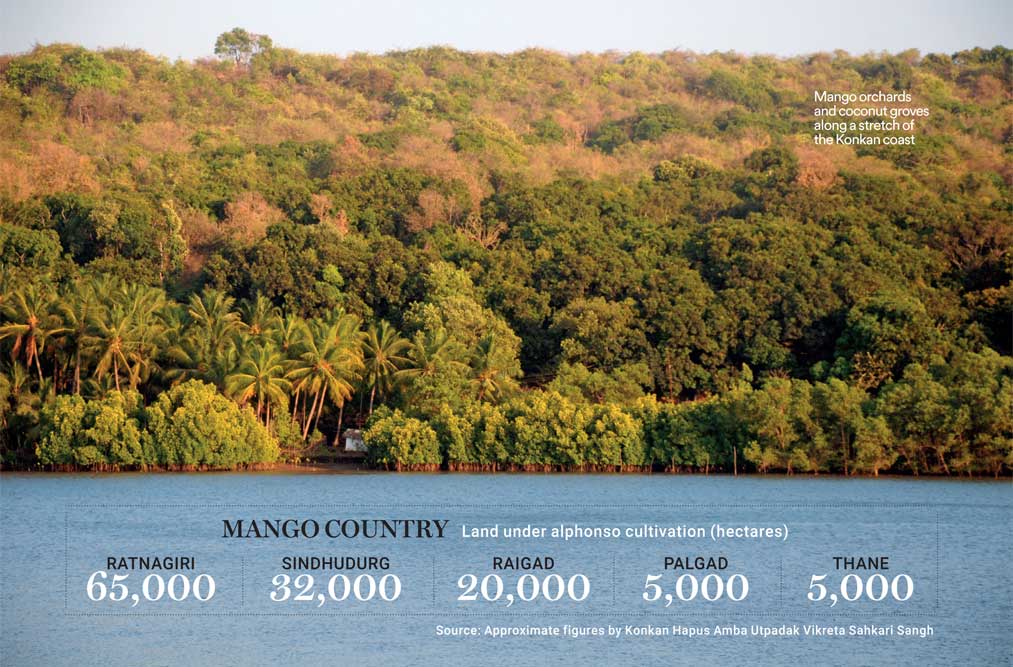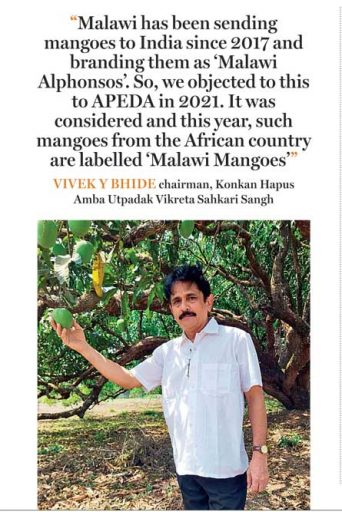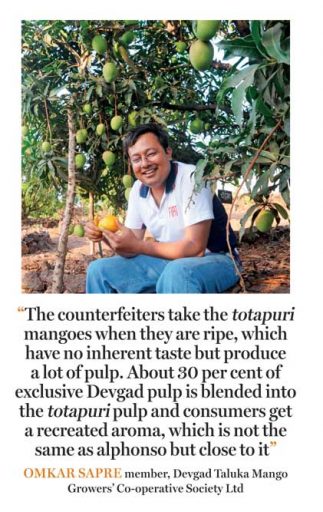The Alphonso Identity Crisis
The king of mangoes has to counter fakes, low productivity and social upheaval despite a GI tag
 Moinak Mitra
Moinak Mitra
 Moinak Mitra
Moinak Mitra
 |
01 Mar, 2024
|
01 Mar, 2024
/wp-content/uploads/2024/02/Alphanso1.jpg)
The sorting of alphonsos at Crawford Market in Mumbai (Photo: Alamy)
THE MANGO SEASON is round the corner but the king of mangoes, the alphonso or hapus in the local Konkan dialect, remains as elusive as the winter sun. If the march of these prized mangoes to the market is being offset by the vagaries of weather on the one hand, counterfeiters at the wholesale and retail level are queering the pitch on the other. Add to this the waning interest in alphonso cultivation among the newer generation of growers who prefer the urban hustle and bustle to a bucolic existence their forefathers had led—an ominous sign that could signal the doom of a fruit that is known the world over for its taste, fragrance and vibrant colour.
As the fable goes, alphonso gets its name from the 15th and 16th-century Portuguese general Afonso de Albuquerque who served as the first Duke of Goa from 1509 to 1515. The Portuguese were expert gardeners and experimented with horticulture grafting fruits and vegetables onto each other. In the 16th century, Garcia de Orta wrote of alphonsos grown in Portuguese Bombay to be presented to the governor in Goa. Now, Omkar Sapre, a lawyer and member of the Devgad Taluka Mango Growers’Co-operative Society Ltd, calls the Portuguese connection“hogwash”. According to him, the fruit came much later, as recently as the 19th century.“Devgad [in Sindhudurg district of the Konkan] used to be a refuelling station for English vessels in the1850s. It also had mango trees, along with the adjoining Ratnagiri and Palgad districts [back then, they all fell in the Ratnagiri district] and people using the harbour started taking a liking to the fruit,” he says, adding that a few generations back, his in-laws had started a ferry service from Devgad to Crawford Market in Mumbai.“That’s how alphonso mangoes of Devgad and Ratnagiri started arriving in the market.”
Now, the local Goan mango that remotely exhibits alphonso traits is called mankhurad, which again is nowhere near the fruit in question. In that case, how did the famed alphonso land in Ratnagiri, Sindhudurg, Palgad, Raigad and Thane—the five districts of the Konkan belt in Maharashtra that now sport the geographical indication (GI) tag for alphonso mangoes? Ratnagiri abuts Goa and Sindhudurg is not far either from the erstwhile Portuguese establishment. Going by Sapre’s theory, ruling out historical record completely seems untenable. However, climate change could be a reason for the shift of the alphonso crop up north from Goa to theKonkan region.
Also, consider the topography of the Konkan belt. Taking the example of Devgad, Sapre explains that, unlike other coastal regions, if one goes inside these areas through several creeks, after about 30m, there will be an incline going in, whereas other coastal areas generally have an incline going down. He reasons that the zone is formed of laterite rocks that hold very little moisture content. “When mangoes were planted in Devgad, they were done by uprooting trees in natural cracks, and that’s where they stabilised,” he says.
The lesser the moisture, the more conducive it is for alphonso growth. After all, the crop displays a botanical characteristic called phenotypic plasticity, or a tendency wherein abiotic (non-living) factors like soil, water, sunlight and wind make an impact on the outcome. So, if one makes grafts from the same mother plant in Konkan and plants it, say in Karnataka, it won’t remain alphonso since it will imbibe local characteristics of soil, water, sunlight, etc. In general, Karnataka has alluvial soil, good for retaining moisture and a far cry from the laterite soil found in the Konkan. So, the mangoes grown in Karnataka will carry a lot of moisture but will have minimal aroma. On the other hand, the five alphonso-growing districts in Maharashtra will have less moisture content but a high level of aromatic compounds and volatile components. The issue is now at the heart of the rampant counterfeiting of alphonso mangoes.
Karnataka, indeed, seems to be the prime culprit flooding the market with alphonso me-toos. How? Many years ago, alphonso saplings were taken from Konkan and planted in the Dharwad region of Karnataka where a bountiful crop is guaranteed owing to conducive climate and soil. Also, the mangoes in the region are cultivated using the ultra-high density format at 624 trees per acre against the old format of 40 trees per acre, which the Konkan region largely deploys. Though in the ultra-high density format, trees are not allowed to grow beyond 20 feet, the farmer gets more usable fruits per tree than the 100 to 150 usable mangoes per tree in the older format. “You get more fruits because the effort of the tree in producing branches and leaves is now diverted to producing fruits,” says Sapre. Though the production is high, the quality of the fruit is nowhere close to alphonso. They look similar to alphonsos though they don’t possess the orange tinge of the fruit and they don’t taste the same. Neither do they have an aroma. Disturbingly, it is this breed of alphonso mangoes that has taken the market by storm.

Similarly, at times, even Kerala hapus wends its way to the market though the fruit is anything but alphonso. Again, come November, mangoes from Malawi in Africa used to join the alphonso chorus. Malawi started growing an ultra-high density Indian variety of alphonso mangoes of the Dapoli region of the Konkan coast on a 400-acre farm while planting around 400 plants an acre. The weather pattern in Malawi is similar to Konkan, but again, the fruit is not quite alphonso. “Malawi has been sending mangoes to India since 2017 and branding them as ‘Malawi Alphonsos’. So, we objected to this to APEDA [Agricultural and Processed Food Products Export Development Authority] in 2021. It was considered and this year, such mangoes from the African country are labelled ‘Malawi Mangoes’. Though they sell for ₹2,000/dozen, they neither resemble alphonso, nor do they have a thin skin like the fruit. The colour is dark yellow and they barely leave an aroma,” explains Dr Vivek Y Bhide, chairman, Konkan Hapus Amba Utpadak Vikreta Sahkari Sangh.
The mixing of such mangoes (barring Malawi mangoes) with alphonso occurs at wholesale and retail levels. To get a grip on the modus operandi, Open spoke to Mukundrao Joshi, director, Konkan Hapus Amba Utpadak Vikreta Sahkari Sangh. The septuagenarian from Ratnagiri city gave a ringside view of how alphonsos land up at the Agricultural Produce Market Committee (APMC) godowns from various farms across Konkan and then get mixed up by various unscrupulous agents and sub-agents in the retail chain until they’re packed off as hapus to the not-so-discerning buyer. “When APMC writes in its books how many mangoes it has received, it states that there are ‘x’ number of mangoes from Maharashtra and ‘y’ number from Karnataka, etc. They don’t earmark the mangoes as alphonso or any other variety. So, the Maharashtra bucket is premixed with other mango varieties from the state, such as langda or kesar. At the wholesale level, the Krishi Utpanna Bazaar Samiti (which is the APMC) in Vashi, Mumbai, is teeming with agents who sell our cases further to sub-agents. They pay us a price, say ₹2,000/case. The alphonso counterfeiting starts at this level where our mangoes get mixed with other varieties when the mangoes go into the retail chain from wholesale. It is the agents who are responsible and they decide the price.”
Joshi has now raised an objection claiming that Karnataka or Kerala can sell their mangoes, but not as alphonsos. “We have sent a notice to the APMC at Vashi in Mumbai to inform Karnataka and Kerala mango associations who are selling such fake alphonsos.” Such associations need to now take up the cudgels against the agents at the APMC who are squarely responsible for the counterfeit alphonsos.
Counterfeiting is not restricted to the fruit alone. The fruit from Devgad, for instance, majorly goes out for pulping where, again, mixing is rampant. Sapre points out that any brand of alphonso pulp in the market sits at ₹150-300 per tin whereas the production cost of his cooperative comes to ₹300 for the same tin, and it vends at ₹800. “The counterfeiters take the totapuri mangoes when they are ripe, which have no inherent taste but produce a lot of pulp. About 30 per cent of exclusive Devgad pulp is blended into the totapuri pulp and consumers get a recreated aroma, which is not the same as alphonso but close to it,” he explains.

Again, Sapre claims that the APMCs are squarely to blame for the counterfeits. On February 20, he received a call on which he learnt that the APMC at Vashi in Mumbai had received 3,000 crates from Devgad that day. On checking with his transporters, he gauged that only one tempo with 150 boxes had headed for the Mumbai godown. “Unless we have financial muscle, we cannot go behind these APMCs and file cases against them.”
The problem is so acute that Prasad Jadhav, a 36-year-old alphonso cultivator from Ratnagiri, sends out a plea. His orchard in Ratnagiri has 800 trees. “We get considerably less per crate owing to the fake alphonsos in circulation from Karnataka and Kerala. If Karnataka mangoes weren’t around, my crate would sell at ₹15,000 today instead of ₹4,000-5,000.” Each crate possesses four to six dozen mangoes.
Armed with the GI tag in 2018, growers from the five alphonso districts of Maharashtra are now on an awareness drive. About 1,700 GI-registered users are constantly keeping a pulse on consumers and the trade. They want consumers to ask sellers if the mangoes bear GI tags or QR codes. With QR codes, each mango now can be easily traced to its origin. A few months back, Mukundrao Joshi tried tagging every single alphonso with a QR code at Dahisar in Mumbai to resounding success. “People called me saying they tasted real hapus for the first time in their life.”
Alphonso farmers are also educating consumers to directly source from them by avoiding counterfeiting middlemen. During the pandemic when the market (read APMC) was shut, claims Joshi, many farmers loaded their tempos with their alphonso produce and sat outside apartment blocks in cities. “They captured a sizeable market through such direct marketing, a positive outcome of Covid-19,” says Joshi.

But the productivity of the alphonso crop is falling year on year. Bhide has seen nature playing truant since the Phyan cyclone of 2009. “After the Phyan cyclone, productivity has come down phenomenally. Over the last 10 years, my profit margin has dropped by 40 per cent and we have been using a lot of pesticides, fungicides and chemicals as the crops are now prone to pest attacks owing to the vagaries of nature,” says Bhide. Take this year, for instance. The crop yield is low. In January, it seemed like a bumper season was ahead but unusually high rains on January 7 and 8 dampened such expectations. As a result, the crop pattern changed. The alphonso flower got infested with thrips and came under control only recently. Though the weather is now favourable, Bhide warns that any sign of rain can be devastating.
Then there is a social dilemma confronting the king of mangoes—not enough hands to till the land. The kids of farmers are on Instagram and other social apps and crave urban plenitude. “They are not interested in farming and are moving out to the cities, primarily Mumbai,” says Sapre. Joshi, too, echoes Sapre’s concern and adds: “Nearly 80 per cent of our orchard workers today are from Nepal, Bihar and Uttar Pradesh.”
The much-cherished alphonso, despite bagging a GI tag, has run into foul weather. The rot in the fruit—which was once decreed by Jawaharlal Nehru to be gifted to VIP guests only, was packed off to London for the Queen’s coronation in 1953 and made its way to America in 2007 in return for the export of Harley-Davidson motorcycles to India—has set in. It is debatable whether the pungent pulp that melts in the mouth and leaves a long aftertaste will continue or disappear like its cousin from the Konkan, the pairi, a juicier mango with a hint of tanginess to it, which is now all but extinct.

/wp-content/uploads/2025/01/Cover_Kumbh.jpg)










More Columns
What does the launch of a new political party with radical background mean for Punjab? Rahul Pandita
5 Proven Tips To Manage Pre-Diabetes Naturally Dr. Kriti Soni
Keeping Bangladesh at Bay Siddharth Singh